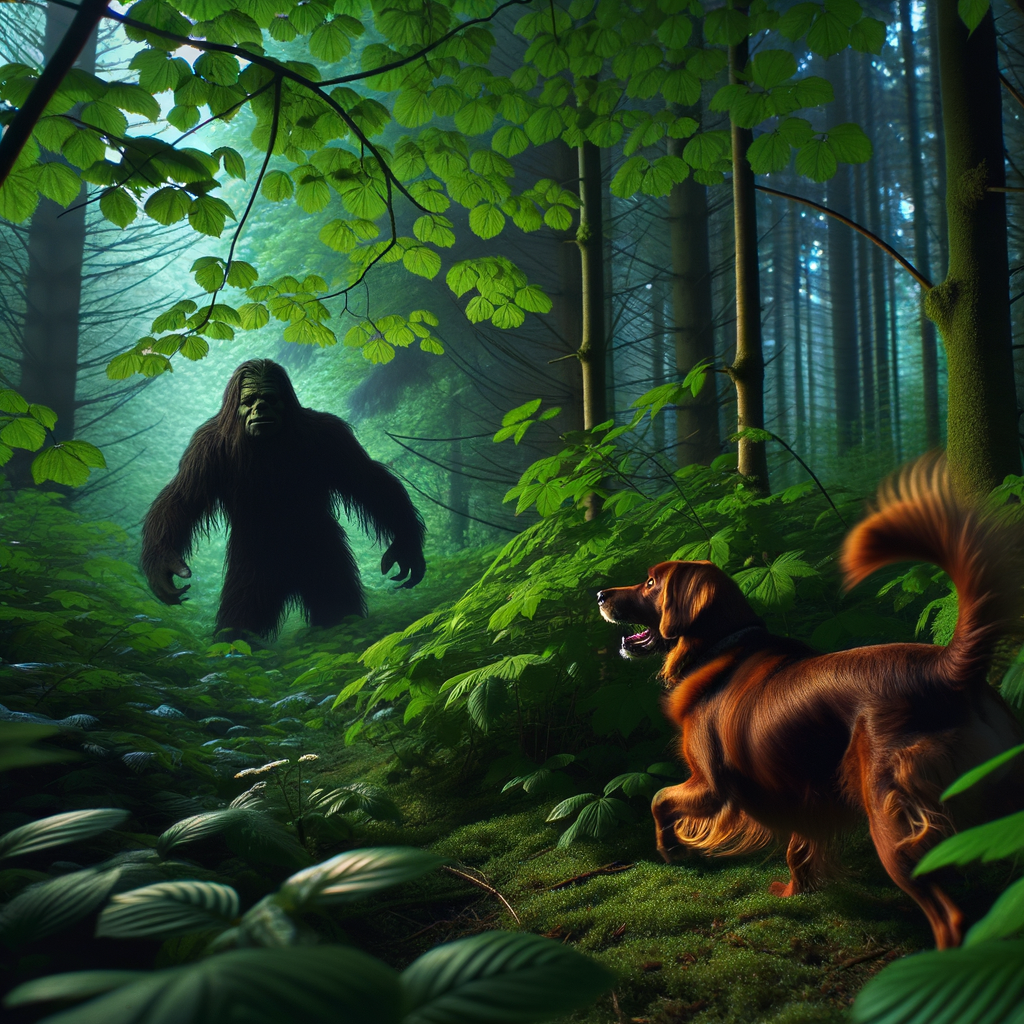Bigfoot and dogs do not like each other very much.
Over the years, there has been a lot of interest in the complicated and fascinating relationship between dogs and Bigfoot. Anecdotal stories and eyewitness testimonies abound regarding dogs’ intense reactions to Bigfoot’s presence. These accounts often indicate how, when sensing Bigfoot around, dogs will often become extremely upset, bark constantly, or even crouch in terror. People frequently believe that dogs exhibiting such behavioral changes are detecting unique and potentially dangerous stimuli in their surroundings.
Dogs on Bigfoot
Many myths and stories from various cultures, especially Native American mythology, frequently portray dogs as protectors or companions in tales featuring Bigfoot. These stories frequently emphasize the dog’s protective function against otherworldly beings, such as big, hairy humanoids like Sasquatch. These stories highlight the importance of dogs’ strong senses and loyalty, which suggests a close, even mystical bond between canines and the natural world—including its more enigmatic denizens like Bigfoot.
There are several conjectures concerning canines’ potential to discover Bigfoot. People believe that dogs, with their more developed senses, such as better hearing and smell, can detect Bigfoot much earlier than humans. According to some views, there may have been past contacts between Bigfoot and the wild progenitors of current dogs, which may have influenced the responses and behaviors seen in domestic dogs today. These hypotheses propose a distinct interspecies dynamic that may help to explain why dogs get so agitated when they hear reports of bigfoot sightings.
Researchers and fans have documented multiple alleged encounters between canines and Bigfoot, contributing to the already enigmatic issue of sasquatch sightings. Stories often highlight the unique reactions and actions dogs display when they come across suspected Bigfoot.

Stories
Here are a few noteworthy instances:
A well-known example is the 1970s experience of a rural Oregon family. The family said that Max, their German Shepherd, would often get quite anxious at night and would bark hysterically into the thick woodland that surrounded their home. The family witnessed the rustling noises and enormous, shadowy creatures moving among the trees on multiple occasions. Max followed the figure one night, but a few minutes later, he returned, clearly terrified and whimpering. The family thought their dog had seen a bigfoot because they discovered sizable, humanoid footprints close to the spot where Max had pursued the creature.
During a trip in the 1980s, some hunters from the Pacific Northwest noticed unusual behavior from their hunting dogs. The dogs, who were usually bold and aggressive hunters, turned away from a scent trail that headed into a densely forested area. Rather, they cowered and moaned, showing signals of anguish and fear. Curious and unnerved by their dogs’ unusual behavior, the hunters checked the area and discovered broken branches and sizable footprints that matched previous tales of Bigfoot activity. This interaction revealed that the dogs were sensing the presence of something unusual and possibly dangerous.
A Bigfoot researcher in the Appalachian Mountains provided a more recent report of an encounter in 2016. Buddy, the researcher’s Labrador Retriever, was working on a nighttime study when the dog abruptly halted and started growling subtly at the obscurity up ahead. Despite being a well-mannered and generally quiet dog, Buddy raised his hackles and refused to move forward. Then, among the trees, the researcher heard heavy footfalls and noticed a tall, dark figure moving. The researcher thought they had gotten a good look at a bigfoot because of Buddy’s strong response and the other noises and visuals they experienced.
Even though these reports are anecdotal, they offer interesting stories about possible interactions between canines and Bigfoot. The recurring theme of dogs exhibiting anxiety, agitation, or refusal to track when in the company of Bigfoot-like entities suggests that they may sense something unusual. Scientists are still investigating these occurrences in the hopes of learning more about Bigfoot’s existence and habits from canines’ acute senses and innate responses.

Bigfoot on Dogs
Based on eyewitness stories and anecdotal evidence, Bigfoot’s stance with dogs seems inconsistent and unclear. These are mostly conjectural observations due to the absence of hard data. However, the recorded interactions have revealed a number of trends.
Bigfoot appears to prefer to stay out of dogs’ faces most of the time. Stories about Bigfoot running away or hiding when dogs start barking or acting aggressively are common. This shows that Bigfoot may avoid dogs in order to avoid attracting attention, viewing them as possible threats or annoyances.
According to some reports, Bigfoot may be curious about dogs and watch them from a distance without making any eye contact. Witnesses claim to have seen Bigfoot observing their dogs from the safety of bushes or trees; this observation suggests a degree of curiosity or interest rather than immediate hostility or fear.
According to some reports, Bigfoot doesn’t seem to mind if there are dogs around. In these situations, Bigfoot adopts a neutral posture and neither runs away nor comes forward with force. This could mean that Bigfoot evaluates the situation and determines that the dogs do not represent a serious threat; therefore, he decides not to attack or flee.
Although less common, there have apparently been instances where Bigfoot has acted aggressively toward dogs. According to these claims, Bigfoot has been seen hurling boulders or sticks at dogs, either as a kind of self-defense or to frighten them away. If Bigfoot perceives the dogs as threatening or cornering him, he may react aggressively.
According to some claims, Bigfoot may show warning signs or even fear of canines. Dogs’ aggressive behavior and loud barking may frighten Bigfoot, causing him to flee and avoid them. This dread may stem from knowledge of dogs’ protective functions and intimate relationships with people.
Conclusion
Bigfoot’s behavior toward dogs appears to be situation-specific, ranging from avoidance and curiosity to neutrality and, in certain instances, aggressiveness. These patterns reflect a complex and varied interaction that mirrors the enigmatic character of Bigfoot itself, offering an insight into Bigfoot’s potential actions and instincts when interacting with canines.





Leave a Reply